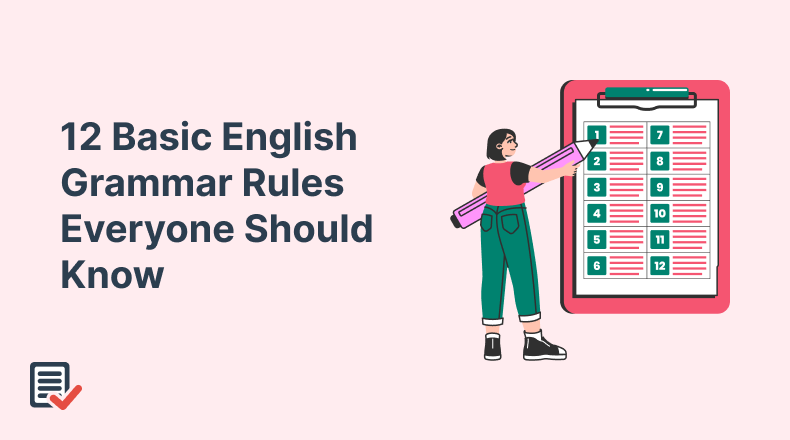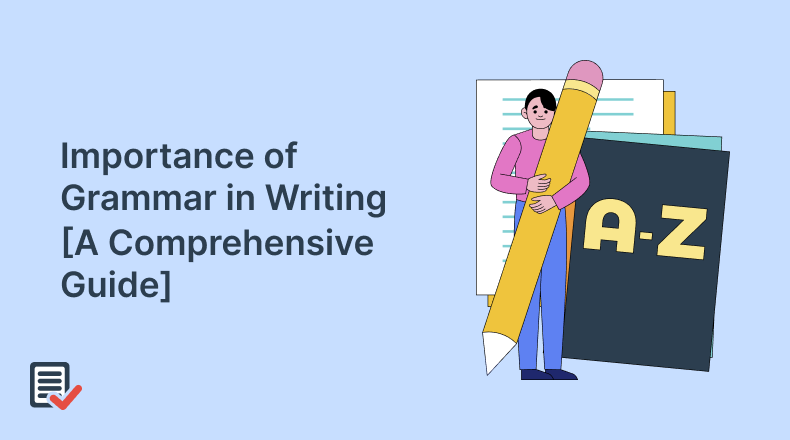
Grammar is one of the most important parts of the English language. Even though words have their meanings, without Grammar they don’t make sense. Grammar helps connect words, giving them context and making them understandable.
That means, without Grammar, your communication would be difficult, especially in writing. You need to understand its rules to have the best grip on Grammar. However, grammar rules can sometimes be tricky to grasp for language learners.
But don’t worry! In this guide, we’ll discuss these English grammar rules for you. These rules of grammar can help you avoid common mistakes and write confidently.
Let’s get started!
Basic Rules of English Grammar
1: Subject-verb Agreement
The term ‘subject-verb agreement’, just like the name suggests, refers to the connection between the subject and the verb. This is mainly concerning singular and plural nouns/pronouns that act as subjects.
For example, in ‘She hates it’, there is a concord between the singular form of the verb and the singular pronoun ‘she’.” This grammar rule specifies the use of a plural verb with a plural subject and a singular verb with a singular subject.
2: Proper Use of Tenses
Every element of Grammar is important, but tenses are often considered the backbone and the most fundamental element. Without tense, everything seems absurd which confuses a lot of people.
The past tense talks about things that have already happened, like “She finished her work.” The present tense discusses current actions, facts, and opinions, like “He writes every day.”
The future tense is usually used to express those things that will happen, like “They will travel next week.” But in writing, it is essential to keep the same tense throughout your text.
If you need to switch tenses, be sure to indicate this change clearly so your readers can easily follow the shift in time. This will make your writing smooth and easy to understand for readers.
3: Correct Use of a, an, the
In English, words like ’a, an & the’ are known as Articles. These terms usually act like adjectives. The definite article ‘The’ is used before a noun to indicate that the noun is specific.
On the other hand, indefinite articles such as ’a & an’ are used when the noun identity is not specified. In some cases, there is no need to add articles.
4: Pronoun-Antecedent Agreement
An antecedent is a word that is usually used in a sentence before a pronoun. It helps you to avoid unnecessary repetition.
Without them, your sentence doesn’t make sense. For example, “Jack went to the store, he bought some chips.” This statement is incorrect because there’s no clear connection between “he” and any noun.
We need to add an antecedent to make the sentence readable; “John went to the store, and he bought some chips.”
5: Use of Active vs. Passive Voice
Did you know that sentences have a voice? It seems surprising but in writing, there are two types of voices – active and passive. These voices refer to whether the subject is active or receiving it.
It depends on which tone you want to use to convey your message. If you want to focus on who is doing the action, then you write your text in an active voice. However, the passive voice works better if the action is more important or the doer is unknown.
6: Proper Punctuation Usage
Punctuation consists of symbols that help separate and clarify words, guiding readers on where your sentence starts or ends, identifying quotations, and more.
Without punctuation marks, your writing becomes difficult to read. Without any of these elements, your writing can end up as a confusing jumble of words. So, It’s essential to use these symbols properly.
7: Correct Placement of Modifiers
Modifiers are placed directly next to the words they describe to maintain clarity and coherence in your writing. They enhance statements by providing more detail, modifying, or qualifying the main idea.
To use modifiers effectively, it’s crucial to understand the rules for their placement. This ensures that modifiers are positioned correctly in your sentences, helping achieve the intended meaning and effect.
8: Use of Apostrophe
Apostrophes have two main purposes in English: showing possession and creating contractions. They indicate missing letters in contractions, such as do not become don’t.
When an apostrophe signals the omission of a letter at the beginning or end of a word, a full space precedes or follows the apostrophe, as in rock’ n’ roll. No space is needed if the apostrophe replaces a letter in the middle of the word, like in ma’am.
9: Avoid Run-on Sentences
When you speak, you naturally pause between phrases to show where each sentence ends. In writing, this pause is represented by marks like periods, question marks, or exclamation points.
If two independent clauses join with each other without any proper mark, it creates a run-on sentence. These sentences make it hard for readers to understand where one sentence ends and another begins. That’s why it’s important to fix these sentences in your writing. You can fix them by using the right Grammar. If you want to join two clauses together, you can add a ‘Comma’ between them.
10: Homophonic Words
Homophones are words that have similar sounds but have distinct meanings and spellings. For example: “there, or their,” “break” or “brake,” and “course” or “coarse.”
When writing, make sure to select the correct spelling of the word. When listening, remember that a word might have a different meaning than what you initially thought. Always try to figure out the correct meaning based on the context.
11: Avoiding Double Negatives
Double negatives are a frequent grammar mistake where two negative terms are used in the same sentence. This results in the sentence having a positive meaning, which can lead to confusion about what you really want to say.
In simple terms, using a double negative leads to misunderstandings. To avoid this, it’s best to use just one negative to clearly express your thoughts and feelings.
12: Use of Conjunctions
Conjunctions might not seem as interesting as nouns, as vivid as adjectives, or action-packed as verbs, but they play an essential role in English.
These small yet powerful words help connect ideas, smooth out rough writing, and create more complex, flowing sentences. With proper conjunction usage, you can improve the structure and clarity of your writing.
Conclusion:
One of the most difficult things about the English language is Grammar rules. Most people are confused about these rules. They don’t know where to add commas, how to make correct sentence structure, or which tense helps convey their message.
We know it’s hard to remember all these rules while writing, but if you continuously practice their usage, you can easily understand them.







![15 Capitalization Rules for English Grammar [With Examples]](https://www.check-plagiarism.com/blog/wp-content/uploads/2024/09/15-capital.png)